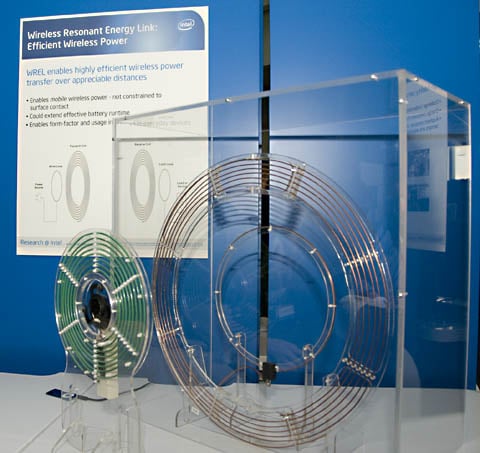This article is more than 1 year old
Intel powers netbook via thin air
Wireless juice due 2015
Research@Intel Wireless power transmission has taken another step towards commercial reality.
At its eighth annual Research@Intel event on Thursday in Mountain View, California, the chip giant gave a crowd-gathering demo of what it calls a Wireless Resonant Energy Link (WREL).
The demo setup included a hefty transmitter and receive-coil pair in which the receive coil had at its center a small speaker, with both the audio signal and the power required to drive the speaker being transmitted wirelessly.
The WREL, as its name implies, transmits power by setting up a resonant relationship between the transmitter and the receive coil, much as does the battery recharger in your wireless electric toothbrush.
However, as Intel researcher Emily Cooper told The Reg, the WREL's power transmission is "very different from the electric toothbrush charger [power] that falls off after about a millimeter."
Although the demo was transmitting only about one or two watts at a distance of over a meter, Cooper claimed that in Intel's Seattle lab, they've managed to power a netbook at distances of between one and two meters, providing between 14 and 20 watts. She also said that lab tests had powered 40 and 60-watt light bulbs.

Intel's wireless-power prototype - transmitter on the right, speaker-equipped receive coil on the left
Cooper demonstrated that the receiver didn't drop or attenuate the signal when it changed its orientation in the transmitted beam. Even at a 90 degrees orientation to the transmitter, the receive coil's tinny speaker's tunes remained equally tinny. Her explanation: "As long as we're capturing some of the flux from this source, we can transduce that."
She also pointed out that the transmitted power is not subject to the familiar inverse square law, which decrees that signal strength is inversely proportional to the square of the distance from the transmitter. "That's what's interesting about this coupling mechanism," she said, "there are ways to make the transfer efficiency constant until you reach a certain point."
When asked what would happen to the signal strength if there were something between the transmitter and the receive coil, Cooper said there'd be a problem "only if there were a Faraday Cage in the middle," and that "certainly this transmitter could be embedded in a wall with plasterboard over it and that wouldn't effect the transmission."
Even such wetware as human beings walking through the transmission path shouldn't effect the signal: "People, not so much - there's really not good coupling with people," Cooper said.
Wireless power transmission has been a dream since the days of Nikola Tesla, and although some progress has been made by researchers at MIT and elsewhere, most wireless-power devices have been of the electric-toothbrush variety.
Wireless-power company Fulton Innovation, for example, has been at it for some time, even demonstrating a wirelessly powered blender. However, that appliance needs to be placed on what the company calls an "Access Point" before it can make a strawberry-banana smoothie.
Powermat also showed wireless rechargers at this year's CES, but again the device to be recharged needs to be placed directly on their eponymously named Powermats. And then there's the progress being made in tiny remote sensors called WISPs (wireless identification and sensing platforms) that draw their power from the ambient energy emitted by sources such as WiFi hotspots, cell towers, or TV broadcast signals.
Of course, there's been a great deal of hubbub - and conflicting studies - about the possible ill effects of even such low-power, inverse-square-law-obedient signal sources as cell-phone towers. Intel is aware of the controversy and has said in a statement about the WREL that "We are investigating the safety and regulatory issues. It is too early to definitively evaluate the safety or regulatory compliance of any proposed product, as basic properties such as transmitted power levels and safety features have not been set yet."
In addition to its regulatory challenges, existing WREL technology is clearly far too large for most commercial uses, but Cooper said that the size of the receive coil is "something we're working on and that's very important to this application space." The goal, she said, is "to be able to scale these to cell-phone size, to laptop-size."
When asked when shrinking the receive coil to a manageable size might allow WREL-enabled products to appear in your local electronics boutique, Cooper said that mid-next-decade was a "reasonable estimate." ®
